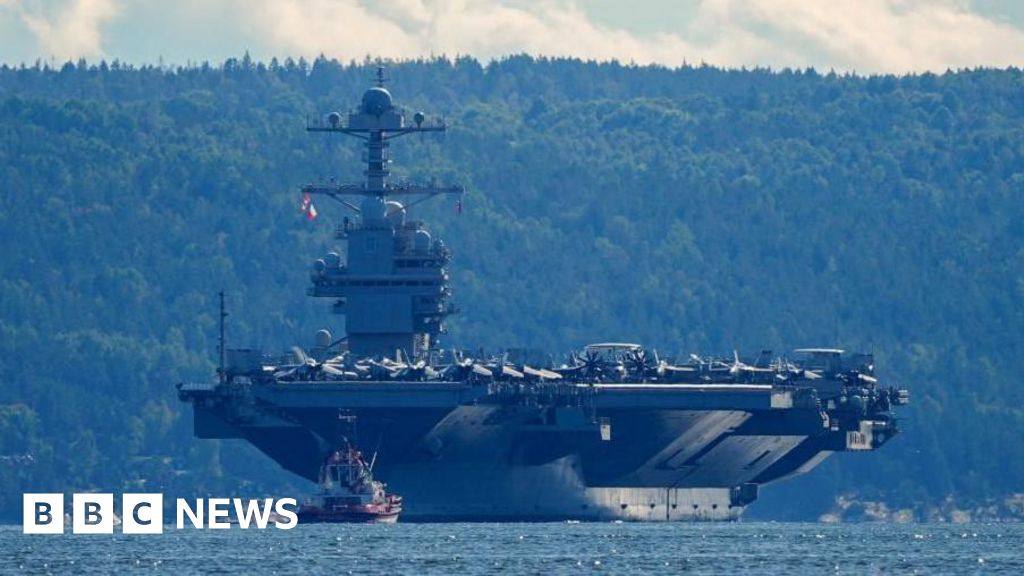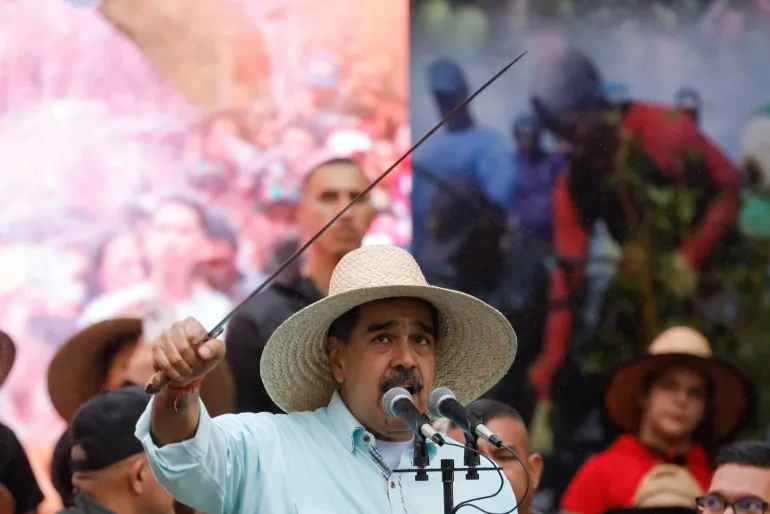Puerto Rico, US Imperialism and Venezuela’s Defiant Sovereignty: A Conversation with Déborah Berman Santana
As the United States reasserts its hemispheric priorities in its recent National Security Strategy document, Latin America and the Caribbean are once again cast as a zone of interest, with Venezuela squarely in Washington’s sights. Puerto Rico—still a US colony more than a century after the 1898 invasion—plays a central role in this imperial architecture, serving as both a military platform and a living example of colonial rule in the region.
Cira Pascual Marquina spoke with Puerto Rican geographer, author, and longtime activist Déborah Berman Santana about the continuity of US imperialism, the island’s strategic function in projecting imperialist military power in the region, and why Venezuela’s insistence on sovereignty represents such a profound threat to US interests.
Drawing on decades of grassroots struggle against militarization, including the successful campaign to halt US Navy bombings in Vieques, Berman Santana situates today’s escalation against Venezuela within a broader history of colonial control, neocolonial coercion, and popular resistance in the continent.
The US has just issued a new National Security Strategy document that shifts its focus to the Western Hemisphere. From your perspective in Puerto Rico, what does this reveal about Washington’s imperial ambitions, and how does it impact the Caribbean and specifically Venezuela?
From Puerto Rico, and with the history of US-Latin American relations in mind, what is being presented as a “new” security strategy is really the old one. Even before the Monroe Doctrine, Thomas Jefferson was already worried that Spain’s colonies might become independent before the United States was strong enough to take control of them. Hemispheric domination has always been central to US policy.
What this document makes clear is that Washington wants absolute control over the Western Hemisphere, regardless of what happens elsewhere in the world or how competition with China or Russia evolves. When US officials say “America for the Americans,” they mean the entire hemisphere for the United States: its peoples and its resources, all under US imperialist control.
The Caribbean is still referred to as the US “backyard,” even by sectors of the US left. Venezuela’s oil—the largest proven reserves on the planet—is treated as US oil. Bolivia’s lithium is viewed as US lithium. The strategy simply reasserts the United States as the dominant power, the plantation owner of the hemisphere.
There is nothing new in this policy paper except how openly it is stated. I don’t believe the substance would be radically different under a Democratic administration; it would simply be expressed in more polite language.
Puerto Rico is identified as a US “territory,” but in reality, it’s an occupied colony. How does that colonial status enable the buildup of US bases and military deployments, and why is Puerto Rico so central to projecting imperialist power in the Caribbean, especially toward Venezuela?
In the US Constitution, “territory” essentially means property. The US Supreme Court has defined Puerto Rico as an unincorporated territory belonging to, but not part of, the United States. “Unincorporated” means there is no obligation to ever make Puerto Rico a state.
The simplest analogy is a pair of shoes: they belong to you, but they are not part of you, and you can dispose of them at will. That is how Puerto Rico is legally understood. We don’t even have the limited sovereignty administratively allowed for Native peoples in the US. This is not my opinion; it is established by Supreme Court rulings.
This colonial condition makes militarization extremely easy. For roughly twenty years there was a visible reduction in US military presence, but that period is clearly over. The US does not need to negotiate with us. If it chooses to offer compensation, it may, but it is under no obligation.
There are six US military bases in Puerto Rico. Four were never meaningfully demilitarized. Two—Ramey in Aguadilla and Roosevelt Roads in Ceiba—were supposedly closed and slated for civilian redevelopment. In practice, that process has been partial at best.
I live near Ceiba, and since the summer, there has been a dramatic increase in military air traffic. The airstrip, which had been used for regional civilian flights since 2004, is now filled with F-35s, Hercules aircraft, and Ospreys. No permission was requested. The military simply took it over.
If the US decides to deploy additional warships or aircraft carrier groups—as it recently did with the USS Gerald R. Ford—it can do so without even consulting us. Whether this is intended as a prelude to an actual attack on Venezuela or primarily as pressure, it clearly sends a message.
It is the logic of a bully: “I am here, and I am ready to hurt you unless you comply.” Even without an invasion, the buildup is meant to force concessions, deepen internal divisions, or provoke instability in Venezuela. I doubt this will succeed, given Venezuela’s strong commitment to sovereignty, but it clearly reflects the US’ strategic thinking.
Venezuela faces escalating economic, political, and military pressure. Why is the Bolivarian Revolution perceived as such a threat to US imperialist interests?
The United States seeks to remain the dominant global power, but when that dominance is challenged—especially by China—it insists on absolute control of this hemisphere. In this worldview, Latin America and the Caribbean are US turf: their resources belong to Washington, and their peoples are treated, implicitly, as subjects.
What the US will not accept is a country that insists on real sovereignty, a country that engages with Washington as an equal. Venezuela’s decision to control its own resources and choose its own trading partners is intolerable to US policymakers.
That is why Cuba has faced a blockade for more than sixty years, why Nicaragua is targeted, and why Venezuela is now under such intense pressure. A Russian ship making a courtesy visit to Venezuela or expanded ties with China are treated not as sovereign decisions, but as provocations.
The real threat to Washington is not Venezuela in isolation, but the precedent it sets. The Bolivarian process represents a living challenge and a model that could inspire others across the region. That is why US policy aims either to overthrow the government or to force it to abandon its sovereign course.
And it would not stop with Venezuela: Cuba would be next, and Nicaragua would follow. Donald Trump has openly warned Colombia’s President Gustavo Petro that they could also “be next.” This military buildup sends a message to all of Latin America and the Caribbean—Mexico included—about the limits Washington seeks to impose on sovereignty.
As one billionaire ally of Trump [Elon Musk] once crudely said about Bolivia’s lithium: “We coup whoever we want.” It may sound blunt, but it reflects a long-standing reality. When US interests are challenged, it resorts to coups—soft or hard. It prefers banks over tanks, but ultimately it will do whatever is necessary to maintain imperialist control.
While Puerto Rico is under direct colonial rule, much of Latin America faces neocolonial domination. How do these models operate together today?
Puerto Rico is a colony with no sovereignty, now effectively governed by a fiscal control board imposed by the US Congress. Appointed under Obama and maintained by subsequent administrations, this unelected body can veto budgets and policies. Its priority is not social well-being, but debt repayment—most of it owed to Wall Street hedge funds.
This structure enforces privatization: electricity, education, and public services. Environmental protections are also under attack. But colonialism works by degrees. A country can be formally independent and still be coerced through debt, IMF pressure, financial blackmail, economic war, etc.
Chile’s water privatization after the Pinochet coup is one example. Haiti is another—it is formally independent, yet occupied and burdened with illegitimate debt. Elsewhere, intervention comes through NGOs, the National Endowment for Democracy, election interference, or direct coups, as in Honduras in 2009.
In Venezuela, when the right wing loses elections, the US cries fraud. When it wins, there is silence. This selective logic serves as justification for sanctions, isolation, and ultimately military threats.
The US justifies its military buildup in the Caribbean using anti-drug rhetoric. What does this narrative conceal?
Historically, Washington claimed to be fighting communism. Later, it was terrorism. Now the target is supposedly drugs. Yet it is widely known that drug demand is driven by the United States itself, and that many of its closest allies have been deeply involved in drug trafficking. It’s allowed as long as they remain politically obedient.
Meanwhile, fisherfolk across the Caribbean are targeted and killed under the pretext of drug interdiction, without evidence and without inspections. This is not about drugs. It is about control.
Most people understand this, even within the United States. The real objective is hemispheric domination and control over strategic resources—above all, Venezuelan oil.
Puerto Rico has a long history of resistance to militarization. How do those struggles connect today with Venezuela and the broader region?
Puerto Rico has consistently resisted US militarism. The struggle against US Navy bombings in Vieques was long and difficult, but it ended in a victory: the base was shut down. Although the land has yet to be fully cleaned up or returned to the community, the pueblo won that battle.
The same anti-militarist, independentista, and socialist forces that fought in Vieques continue to resist today, grounded in the understanding that Puerto Rico is part of the Caribbean and Latin America. Simón Bolívar himself insisted that his liberation project would remain incomplete without Cuba and Puerto Rico.This struggle is far from over. It will not be complete until Puerto Rico is free and can stand alongside Venezuela, Cuba, and other pueblos of the region in a hemisphere that truly belongs to its people—free, just, and sovereign.




